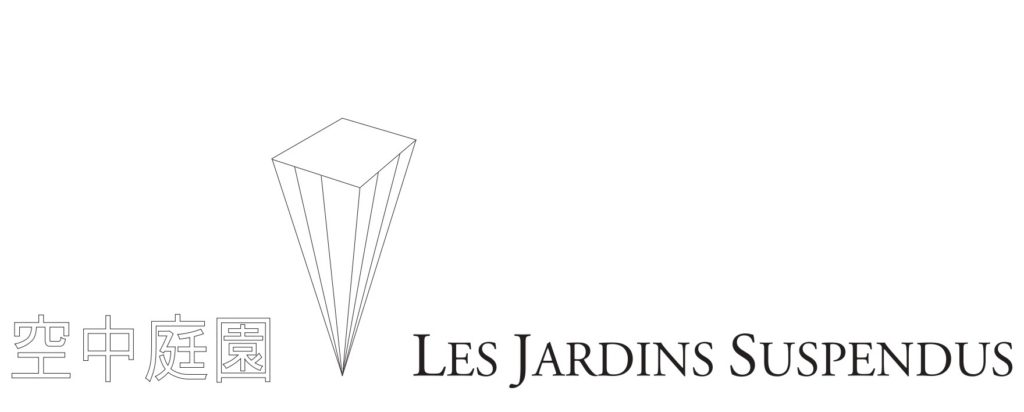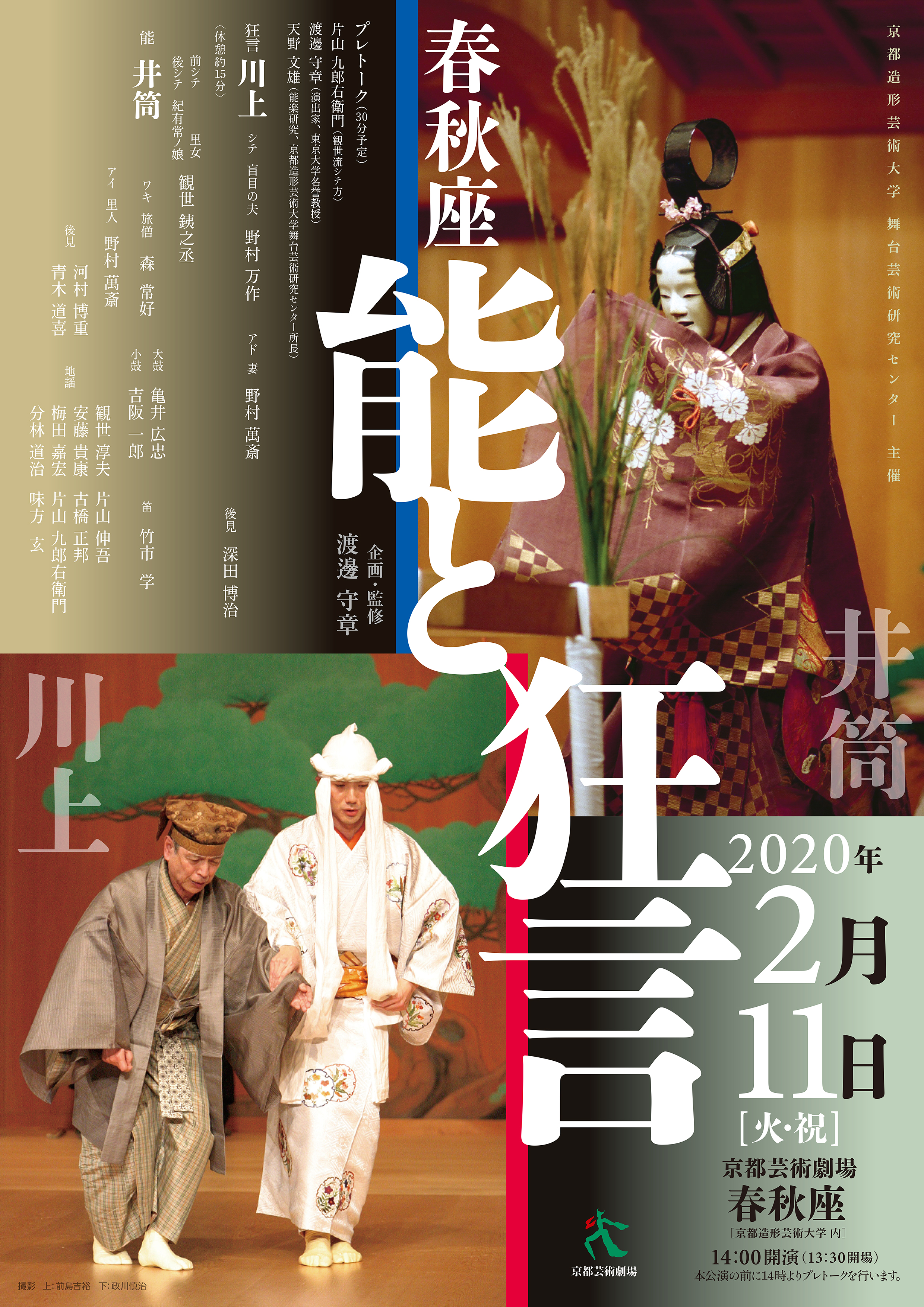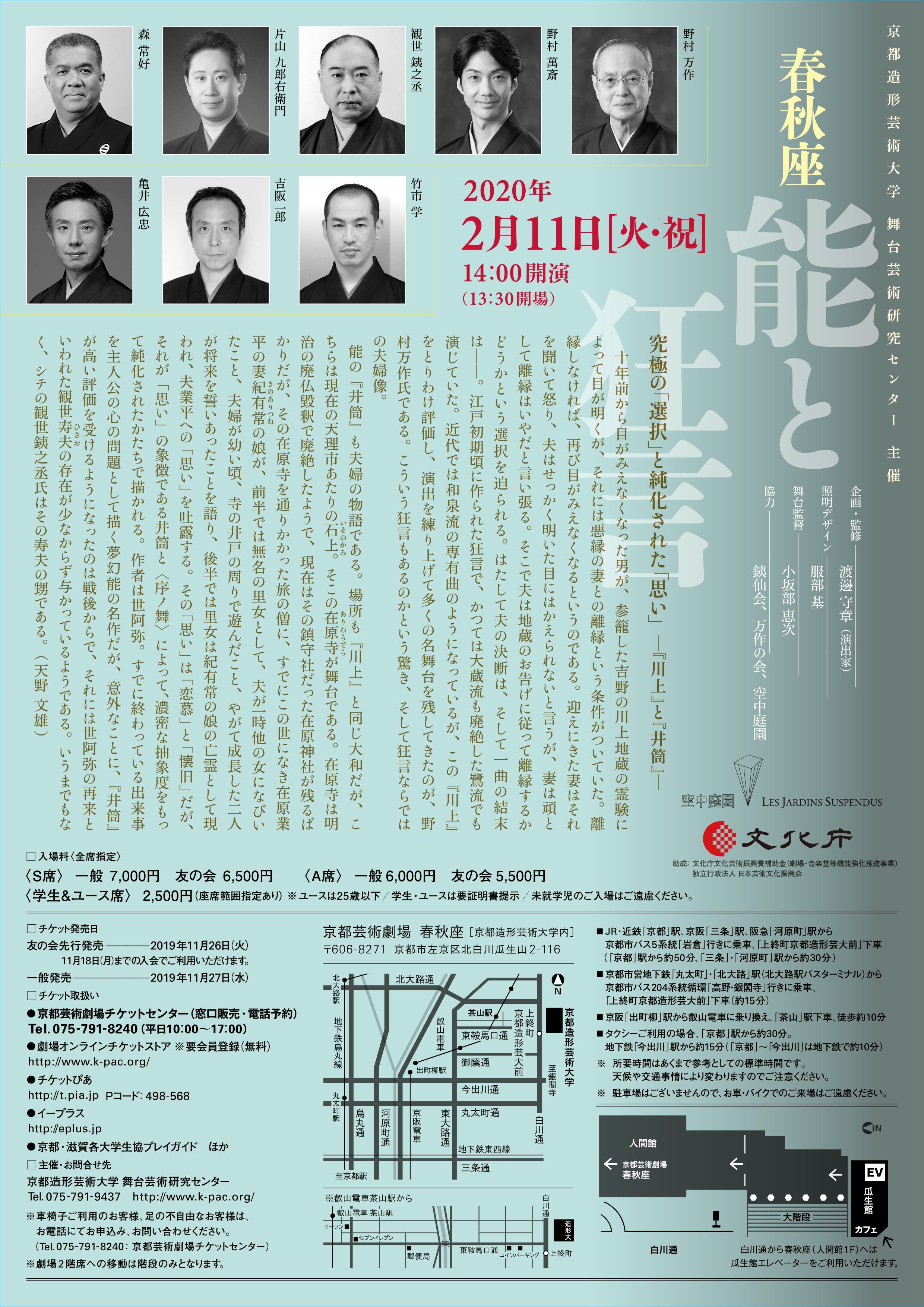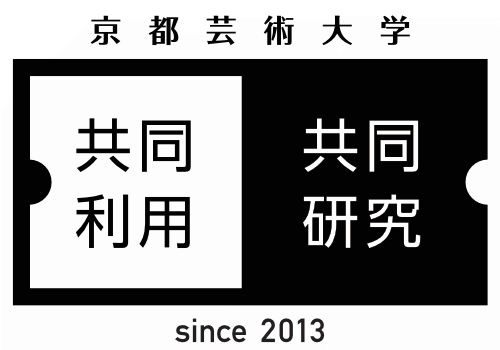公演詳細
主催公演
春秋座―能と狂言
歌舞伎劇場の空間で、伝統的な能・狂言の演目をお楽しみいただく春秋座恒例企画
究極の「選択」と純化された「思い」ー『川上』と『井筒』ー
十年前から目がみえなくなった男が、参籠した吉野の川上地蔵の霊験によって目を明くが、それには悪縁の妻との離縁という条件がついていた。離縁しなければ、再び目がみえなくなるというのである。迎えにきた妻はそれを聞いて怒り、夫はせっかく明いた目にはかえられないと言うが、妻は頑として離縁はいやだと言い張る。そこで夫は地蔵のお告げに従って離縁するかどうかという選択を迫られる。はたして夫の決断は、そして一曲の結末はーー。江戸初期頃に作られた狂言で、かつては大蔵流も廃絶した鷺流でも演じていた。近代では和泉流の専有曲のようになっているが、この『川上』をとりわけ評価し、演出を練り上げて多くの名舞台を残してきたのが、野村万作氏である。こういう狂言もあるのかという驚き、そして狂言ならではの夫婦像。
能の『井筒』も夫婦の物語である。場所も『川上』と同じ大和だが、こちらは現在の天理市のあたりの石上(いそのかみ)。そこの在原寺(ありわらでら)が舞台である。在原寺は明治の廃仏毀釈で廃絶したようで、現在はその鎮守社だった在原神社が残るばかりだが、その在原寺を通りかかった旅の僧に、すでにこの世になき在原業平の妻紀有常(きのありつね)の娘が、前半では無名の里女として、夫が一時他の女になびいたこと、夫婦が幼い頃、寺の井戸の周りで遊んだこと、やがて成長した二人が将来を誓いあったことを語り、後半では里女は紀有常の娘の亡霊として現われ、夫業平への「思い」を吐露する。その「思い」は「恋慕」と「懐旧」だが、それが「思い」の象徴である井筒と〈序ノ舞〉によって、濃密な抽象度をもって純化されたかたちで描かれる。作者は世阿弥。すでに終わっている出来事を主人公の心の問題として描く夢幻能の名作だが、意外なことに、『井筒』が高い評価を受けるようになったのは戦後からで、それには世阿弥の再来といわれた観世寿夫の存在が少なからず与かっているようである。いうまでもなく、シテの観世銕之丞氏はその寿夫の甥である。(天野 文雄)
上演前に読んでおくと、さらに舞台が面白くなる『井筒』の詞章を掲載中!
下の画像をクリックするとPDFが開きます。

究極の「選択」と純化された「思い」ー『川上』と『井筒』ー
十年前から目がみえなくなった男が、参籠した吉野の川上地蔵の霊験によって目を明くが、それには悪縁の妻との離縁という条件がついていた。離縁しなければ、再び目がみえなくなるというのである。迎えにきた妻はそれを聞いて怒り、夫はせっかく明いた目にはかえられないと言うが、妻は頑として離縁はいやだと言い張る。そこで夫は地蔵のお告げに従って離縁するかどうかという選択を迫られる。はたして夫の決断は、そして一曲の結末はーー。江戸初期頃に作られた狂言で、かつては大蔵流も廃絶した鷺流でも演じていた。近代では和泉流の専有曲のようになっているが、この『川上』をとりわけ評価し、演出を練り上げて多くの名舞台を残してきたのが、野村万作氏である。こういう狂言もあるのかという驚き、そして狂言ならではの夫婦像。
能の『井筒』も夫婦の物語である。場所も『川上』と同じ大和だが、こちらは現在の天理市のあたりの石上(いそのかみ)。そこの在原寺(ありわらでら)が舞台である。在原寺は明治の廃仏毀釈で廃絶したようで、現在はその鎮守社だった在原神社が残るばかりだが、その在原寺を通りかかった旅の僧に、すでにこの世になき在原業平の妻紀有常(きのありつね)の娘が、前半では無名の里女として、夫が一時他の女になびいたこと、夫婦が幼い頃、寺の井戸の周りで遊んだこと、やがて成長した二人が将来を誓いあったことを語り、後半では里女は紀有常の娘の亡霊として現われ、夫業平への「思い」を吐露する。その「思い」は「恋慕」と「懐旧」だが、それが「思い」の象徴である井筒と〈序ノ舞〉によって、濃密な抽象度をもって純化されたかたちで描かれる。作者は世阿弥。すでに終わっている出来事を主人公の心の問題として描く夢幻能の名作だが、意外なことに、『井筒』が高い評価を受けるようになったのは戦後からで、それには世阿弥の再来といわれた観世寿夫の存在が少なからず与かっているようである。いうまでもなく、シテの観世銕之丞氏はその寿夫の甥である。(天野 文雄)
上演前に読んでおくと、さらに舞台が面白くなる『井筒』の詞章を掲載中!
下の画像をクリックするとPDFが開きます。

・
公演情報
2020年2月11日(火・祝)14:00
※本公演より前に14時よりプレトークを行います。
※S席は完売いたしました
会場:春秋座
公演内容
プレトーク(約30分予定)
片山九郎右衛門(観世流シテ方)
渡邊守章(演出家、東京大学名誉教授)
天野文雄(能楽研究、京都造形芸術大学舞台芸術研究センター所長)
狂言 川上
シテ 盲目の夫 野村万作
アド 妻 野村萬斎
後見 深田博治
〈休憩約15分〉
能 井筒
前シテ 里女
後シテ 紀有常ノ娘
観世銕之丞
ワキ 旅僧 森常好
アイ 里人 野村萬斎
笛 竹市学
小鼓 吉阪一郎
大鼓 亀井広忠
後見
青木道喜
河村博重
地謡
片山九郎右衛門
古橋正邦
味方玄
片山伸吾
分林道治
梅田嘉宏
安藤貴康
観世淳夫
【企画・監修】 渡邊守章
【照明デザイン】服部基
【舞台監督】 小坂部恵次
【協力】 銕仙会、万作の会、空中庭園

助成:文化庁文化芸術振興費補助金(劇場・音楽堂等機能強化推進事業)|独立行政法人日本芸術文化振興会

チケット情報
全席指定
友の会先行発売 11月26日(火)10:00
一般発売 11月27日(水)10:00
※友の会先行発売は11月18日(月)までの入会でご利用いただけます。ご入会はこちら
〈S席〉完売いたしました
一般 7000円
友の会 6500円
〈A席〉
一般 6000円
友の会 5500円
〈学生&ユース席〉
2500円(座席範囲指定あり)
※未就学児のご入場はご遠慮ください。

その他プレイガイド



一般発売 11月27日(水)10:00
※友の会先行発売は11月18日(月)までの入会でご利用いただけます。ご入会はこちら
〈S席〉完売いたしました
〈A席〉
一般 6000円
友の会 5500円
〈学生&ユース席〉
2500円(座席範囲指定あり)
※未就学児のご入場はご遠慮ください。

その他プレイガイド
English
Shunjuza Noh and Kyogen
11 February 2020, Tuesday, holiday
Kyoto Art Theater Shunjuza
From 2 PM
Theater opens 1:30PM
This is a popular series of Shunjuza Theatre, which attempts to utilize the space and Hanamichi of kabuki theatre for classical Noh and Kyogen.
By using a dynamic space different from the traditional Noh theatre, we can enjoy new theatrical creations.
Starring
Kanze Tetsunojo, Nomura Mansaku, and Nomura Mansai, and more.
Ticket Now on sale
Reserved seat
S seat: 7,000 yen sold out
A seat: 6,000 yen
U-25 and Students(Limited Seats) : 2,500 yen
・U-25 and Students have a valid ID required for purchase and to enter
・All seats reserved
・Please refrain from bringing reschoolers (age 5 & under)
Presented by Kyoto Performing Arts Center at Kyoto University of Art and Design
Supported by the Agency for Cultural Affairs, Government of Japan
<Plan, Supervisor> Moriaki Watanabe
【Program】
Noh have been performed since the 14th century. Many characters are masked, with men playing male and female roles.
It is basically a dance form.
Kyogen has developed along Noh, and often played between intermissions of Noh play. However, it is not all similar to formal
and symbolic Noh play. Kyogen is comical. It is basically phrases and singing.
・Pre-Performance Talk (Japanese only)
・Kyogen ”KAWAKAMI”
A man who had been blind for ten years prays to an image of bodhisattva called Kawakami Jizo in the Yoshino district and regains his eyesight.
The deity, however, tells the man that his wife is the source of his ill destiny, and unless he divorces her, he will lose his eyesight again.
Hearing this, his wife protests fiercely to that idea. The man has to make a choice of whether to follow the guidance of Kawakami bodhisattva or lose his eyesight for good .
・Noh ”IZUTSU”
A travelling monk (Waki, or the supporting character) visits the Ariwara Temple at the village of Iso-no-Kami of the Land of Yamato.
He meets a local woman (the first Shite, or the main character) who was offering water and flowers at a mound precinct,
which turns out to be the grave of Ariwara-no-Narihira. The woman tells him of the love story of this poet and the daughter of Kino Aritsune.
She tells him that the two have been childhood friends who played with each other by a well, sometimes observing their reflections on the water.
Then, the woman confesses that she is the spirit of the daughter of Aritsune and disappears.
Night comes, and in his dream, the monk sees the spirit of Aritsune’s daughter, dressed in her husband Narihira’s attires (the latter Shite, or the main character).
She starts dancing, intoxicated with the feeling of oneness with her lover. In the height of her rapture, the woman looks into the well and sees the reflection.
Recalling the happy days, the spirit eventually disappears again.
【TICKET】
Box Office / Phone
Kyoto Art Theater Shunjuza
TEL 075-791-8240 (Mon-Fri 10:00-17:00)
Online * Pre-registration required
https://www.gettiis.jp/en/event/detail/12768/200211106
※credit card only (visa, mastercard)
Pick up tickets at local 7-Eleven convenience stores in Japan
【ACCESS】
Kyoto Art Theater Shunjuza
Kyoto University of Arts and Design
2-116 Uryuyama, Kitashirakawa, Sakyo-ku, Kyoto 606-8271 Japan
From JR Kyoto station, Keihan Sanjo station, Hankyu Kawaramachi station
→Take bus #5 for Iwakura, get off at Kamihatecho Kyoto Zokei Geijyutsu Daigaku Mae (about 50 minutes from JR Kyoto)
From subway Marutamachi or Kitaoji station
→Take bus #204,get off at Kamihatecho Kyoto Zokei Geijyutsu Daigaku Mae (about 15 minutes from each station)
From Keihan Demachi Yanagi station
→Transfer to Eizan Densha line, get off at Chayama station. About 15 minutes-walk from Chayama.
→It takes 10 minutes by taxi to the University.
※There is NO parking space for cars and motorcycles at the University.
11 February 2020, Tuesday, holiday
Kyoto Art Theater Shunjuza
From 2 PM
Theater opens 1:30PM
This is a popular series of Shunjuza Theatre, which attempts to utilize the space and Hanamichi of kabuki theatre for classical Noh and Kyogen.
By using a dynamic space different from the traditional Noh theatre, we can enjoy new theatrical creations.
Starring
Kanze Tetsunojo, Nomura Mansaku, and Nomura Mansai, and more.
Ticket Now on sale
Reserved seat
S seat:
A seat: 6,000 yen
U-25 and Students(Limited Seats) : 2,500 yen
・U-25 and Students have a valid ID required for purchase and to enter
・All seats reserved
・Please refrain from bringing reschoolers (age 5 & under)
Presented by Kyoto Performing Arts Center at Kyoto University of Art and Design
Supported by the Agency for Cultural Affairs, Government of Japan
<Plan, Supervisor> Moriaki Watanabe
【Program】
Noh have been performed since the 14th century. Many characters are masked, with men playing male and female roles.
It is basically a dance form.
Kyogen has developed along Noh, and often played between intermissions of Noh play. However, it is not all similar to formal
and symbolic Noh play. Kyogen is comical. It is basically phrases and singing.
・Pre-Performance Talk (Japanese only)
・Kyogen ”KAWAKAMI”
A man who had been blind for ten years prays to an image of bodhisattva called Kawakami Jizo in the Yoshino district and regains his eyesight.
The deity, however, tells the man that his wife is the source of his ill destiny, and unless he divorces her, he will lose his eyesight again.
Hearing this, his wife protests fiercely to that idea. The man has to make a choice of whether to follow the guidance of Kawakami bodhisattva or lose his eyesight for good .
・Noh ”IZUTSU”
A travelling monk (Waki, or the supporting character) visits the Ariwara Temple at the village of Iso-no-Kami of the Land of Yamato.
He meets a local woman (the first Shite, or the main character) who was offering water and flowers at a mound precinct,
which turns out to be the grave of Ariwara-no-Narihira. The woman tells him of the love story of this poet and the daughter of Kino Aritsune.
She tells him that the two have been childhood friends who played with each other by a well, sometimes observing their reflections on the water.
Then, the woman confesses that she is the spirit of the daughter of Aritsune and disappears.
Night comes, and in his dream, the monk sees the spirit of Aritsune’s daughter, dressed in her husband Narihira’s attires (the latter Shite, or the main character).
She starts dancing, intoxicated with the feeling of oneness with her lover. In the height of her rapture, the woman looks into the well and sees the reflection.
Recalling the happy days, the spirit eventually disappears again.
【TICKET】
Box Office / Phone
Kyoto Art Theater Shunjuza
TEL 075-791-8240 (Mon-Fri 10:00-17:00)
Online * Pre-registration required
https://www.gettiis.jp/en/event/detail/12768/200211106
※credit card only (visa, mastercard)
Pick up tickets at local 7-Eleven convenience stores in Japan
【ACCESS】
Kyoto Art Theater Shunjuza
Kyoto University of Arts and Design
2-116 Uryuyama, Kitashirakawa, Sakyo-ku, Kyoto 606-8271 Japan
From JR Kyoto station, Keihan Sanjo station, Hankyu Kawaramachi station
→Take bus #5 for Iwakura, get off at Kamihatecho Kyoto Zokei Geijyutsu Daigaku Mae (about 50 minutes from JR Kyoto)
From subway Marutamachi or Kitaoji station
→Take bus #204,get off at Kamihatecho Kyoto Zokei Geijyutsu Daigaku Mae (about 15 minutes from each station)
From Keihan Demachi Yanagi station
→Transfer to Eizan Densha line, get off at Chayama station. About 15 minutes-walk from Chayama.
→It takes 10 minutes by taxi to the University.
※There is NO parking space for cars and motorcycles at the University.





